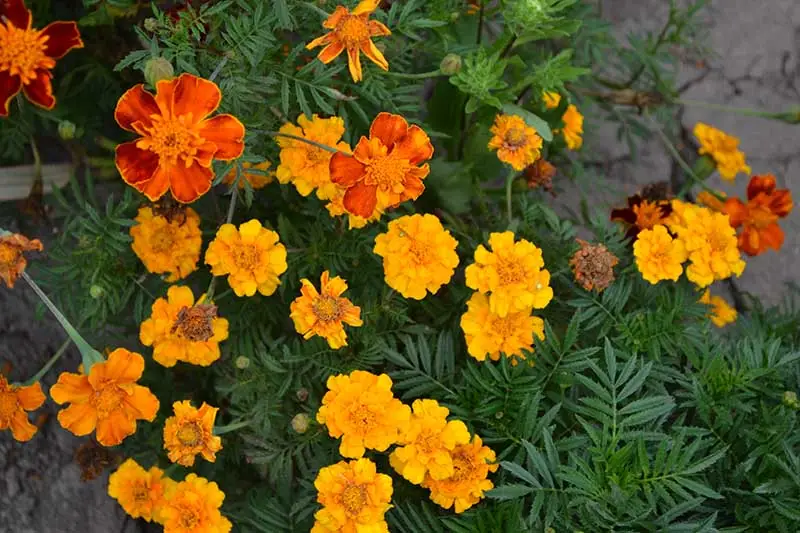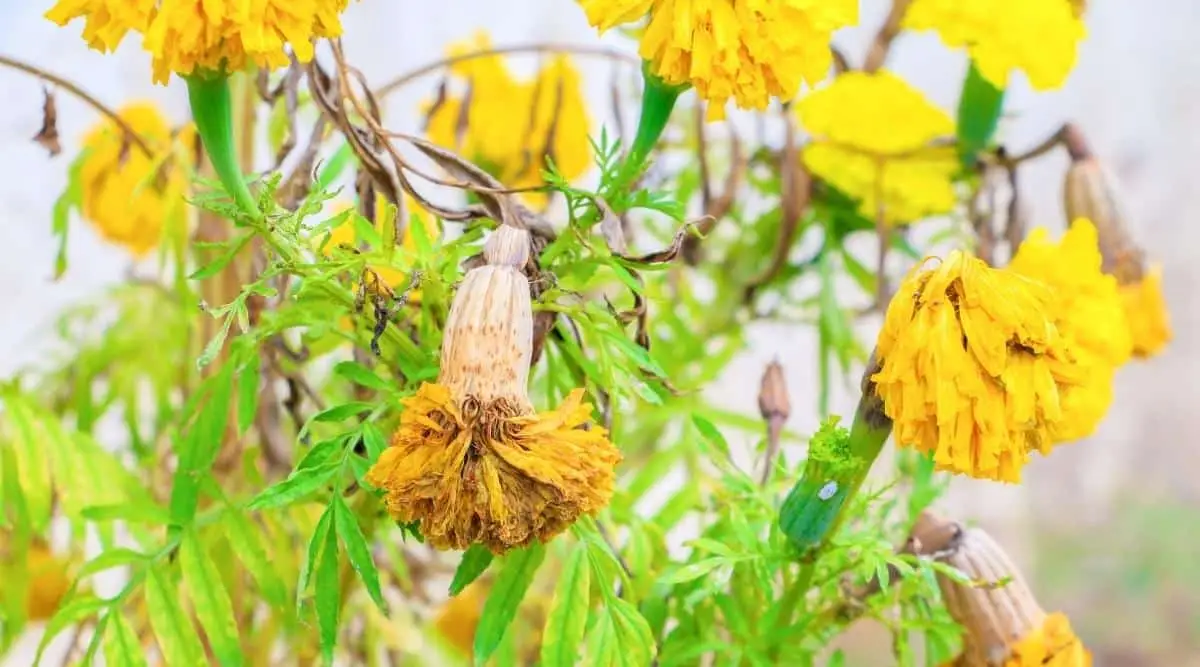Transplant shocks can cause severe damage to marigold plants and even kill them. As a marigold aficionado, you must take prompt action to fight and cure it.
So, what to do in the event of a marigold transplant shock?
Proper watering, fertilization, and mulching can all help support the root system and promote healthy growth after transplantation. Avoiding over-watering or over-fertilizing is also important. Since the root system is not working at its best, trimming back parts of plants can help it conserve energy.
This article will cover everything you need to know about transplant shock in marigolds.
What Causes Marigold Transplant Shock?
Your marigold plant gets a bit of a shock when you move it from one place to another since it never expected this sudden relocation.
A transplanted marigold lacks an extensive root system due to its transplantation. The marigold plant loses some roots and rootlets during the process, which reduces its ability to absorb water.
As a result, they can’t carry out their regular activities, such as the absorption of water and nutrients. Thus, the plant is more vulnerable to disease, insects, and injuries from outside.
Marigold plant transplant shock is influenced by several factors, including-
Injured Root System:
Because of the transplantation, it’s common for marigold plants to lose a portion of their extensive root system. Or, the roots can even be damaged during the transplantation process.
Poor or damaged root systems can cause transplanted marigold plants to fail to establish and become weak and susceptible to other stressors. On top of that, exposure of roots to the air can cause tiny rootlets to dry out and die off, disrupting the root system.
Planting and Watering:
Improper planting and watering can cause issues such as suffocation of roots or root stress. It is important to plant at the correct depth and provide proper watering.
Companion Plants:
Surrounding plants in the new environment can also influence the transplanted marigold plant’s stress level.
Several flowers and vegetables, like zinnia, lavender, cosmos, tomatoes, basil, mint, etc., are good companion plants for marigolds. On the contrary, beans and cabbage will not serve as good companions for marigold plants.
Soil Type:
Different soil types in the same garden can also play a role in transplant shock, as the marigold plant may not be suited to the new soil type.
Marigolds have been known to thrive in loamy, well-drained soil.

What are the Signs of Transplant Shock on Marigold Plants?
The signs of transplant shock can be a warning sign that the marigold is struggling to adapt and recover. Being aware of the signs of transplant shock can help gardeners take the appropriate steps to minimize the stress on the plant and help it recover.
- Wilting and Yellowing Leaves: One of the most common signs of transplant shock is wilting. The plant may appear limp and droopy.
Another sign of transplant shock is yellowing leaves. The leaves may appear pale or yellow and may fall off easily. But yellow leaves do not always mean transplant shock. For example, the Pride of Barbados develops yellow leaves due to overwatering.
- Lack of Growth: A lack of growth is also a sign of transplant shock. The plant may not produce new leaves or flowers, and the stem may appear stunted.
Do Marigold Plants Recover From Transplant Shock?
Yes, marigold plants can recover from transplant shock with proper care and attention. But the process is time-consuming and you should be patient while the plant is in recovery.

How to Cure Transplant Shock in Marigold Plants?
Now that you are assured of the recovery of your beloved marigold plant, it’s time we let you know how to take care of it.
The transplant process is more or less inevitable, so there is no instant cure for it. Special care for some time will require to make the plant recover. Here is what you can do to help the plant feel at home again-
Step One: Trim Some Portion of the Plant
By trimming back transplanted marigold plants, it can conserve energy. The plant can then use that to focus on regrowth, which speeds up the recovery process. Here is how to trim your marigold plant-
- Use your thumb and index fingernail to pinch off the top of each shoot, including the uppermost set of leaves, by cutting the stem just above a pair of leaves. This technique is called “pinching back.” This method also promotes branching.
- Remove spent blooms from marigolds on a regular basis. This can be done by cutting off the flowers and stem back to a set of leaves or the junction with another stem and discarding them. A good practice is to check the marigolds every 5-7 days and remove any spent blooms in sight.
- Remove any leaves, flowers, or stems that have symptoms of disease, such as brown spots or fuzzy gray mold, or that appear to be infested by caterpillars, leafminers, spider mites, or other pests.

Step Two: Use Plenty of Water
The best way to get a marigold plant out of shock is to hydrate it more than usual. Keeping the roots continuously hydrated will make the relocation process faster.
However, some gardeners believe that using a 50-50 milk-water solution on their marigolds can help them recover from shock faster. But in truth, this will not harm the plant and may even be useful; using plain water is sufficient. The key point is hydration.
But if your plant is not in transplant shock, overwatering will rot its roots and kill it. One of the signs of root rot is that the stems are wrinkled and squishy.
Mythbusting: Is Sugar Water Good For Marigold Plants?
One of the most common myths that are believed by gardeners is that sugar water can revive marigold plants in transplant shock. This is widely believed and practiced among gardeners worldwide.
However, soil scientists have proven that this is not the case. The right amount of sugar may be beneficial for a marigold plant, but there is no way to determine what the right amount is.
So, applying sugar water is a big and probably fruitless risk.
If you would like to know more about this, you can watch this video-
Step Three: Apply Fertilizer
Apply a 5-10-5 ratio of granular fertilizer at half the recommended strength to the transplanted marigolds two weeks after transplantation. This fertilizer will encourage growth in roots, flowers, and foliage.
Also, choosing a superior fertilizer at such a delicate stage is crucial.
To suppress weed growth and slow moisture loss from the soil, spread a 1- to 2-inch layer of organic mulch around each marigold. To prevent fungal diseases or insect infestations, leave a small gap, around one inch, between the mulch and the plants.
How Long Does Transplant Shock Last In Plants?
Generally, it can take anywhere from a few days to 2-3 weeks for the marigold plant to recover from transplant shock. However, in some cases, it can take longer for the plant to fully recover, particularly if the conditions are not ideal.
The length of time that transplant shock lasts in marigold plants can vary depending on several factors, such as the size of the plant, the condition of the soil, and the amount of care the plant receives after transplanting.
The better and more appropriate care it receives, the faster it should recover.
How to Prevent Transplant Shock in Marigold Plants?
The prevention steps are very straightforward with the marigold plants. These steps are simple, doable, and can significantly reduce root system stress.
- Keep the Roots Moist: Maintain moist soil after transplantation by watering the new soil consistently and not letting it become waterlogged. This will minimize the amount of stress on the roots and prevent them from drying out.
- Transplant at the Right Time: The ideal time to transplant marigold plants is during the cool season, such as in the spring or fall when temperatures are mild and there is adequate moisture in the soil. Transplanting during the hot summer months can be particularly stressful for the plant and may lead to a greater risk of transplant shock.
It is also important to keep in mind not to plant the marigold deeper than it was planted before. A 6-inch-deep hole should have enough depth.
- Maximize Root Collection: A damaged root system can stress the plant and slow its growth, so maximize root collection. A plant’s survival and healthy growth depend on collecting as much root as possible while transplanting.
- Minimize Root Disturbance: When transplanting, try to minimize the amount of disturbance to the roots. This can be done by gently handling the root ball and ensuring that the soil is well-draining.
Dig a hole twice as deep as the root ball. Handle the root ball gently and keep it together as much as possible.
Frequently Asked Questions (FAQs):
Does Marigold transplant well?
Yes, marigold plants can transplant well if proper steps are taken to minimize transplant shock. This includes selecting the right time of year to transplant, preparing the soil in the new location, and carefully handling the root system during the transplant process.
Can you transplant marigolds in the fall?
Yes, you can transplant marigolds in the fall. Fall is considered an ideal time to transplant marigold plants as the weather is mild and there is adequate moisture in the soil. The cooler temperatures and shorter days of fall will reduce stress on the plant, allowing it to focus on developing a strong root system before the winter.
Do marigolds have deep roots?
No, marigolds have a shallow root system. Their roots are fibrous and spread out horizontally, rather than growing deep into the soil. Marigold roots are no more than a few inches deep, so they can make do with shallow soil layers.
Conclusion
Marigold transplant shock is a common issue faced by gardeners when transplanting marigold plants. It can cause stress to the root system, resulting in wilted leaves, yellowing, and a lack of growth.
However, with proper preparation and care, it is possible to minimize transplant shock and ensure the successful transplantation of marigold plants.
- Why Are There Still No Tomatoes in My Tomato Plants? Let’s Fix the Issue! - July 13, 2023
- Water Propagation White Stuff on Roots: Everything You Should Know! - July 11, 2023
- String of Dolphins Drying Up: Solved! - July 11, 2023

